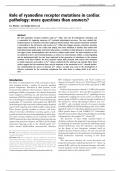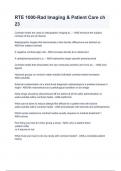Ion Channels: Communication across Membranes 913
Role of ryanodine receptor mutations in cardiac
pathology: more questions than answers?
N.L. Thomas1 , C.H. George and F.A. Lai
Department of Cardiology, Wales Heart Research Institute, School of Medicine, Cardiff University, Cardiff CF14 4XN, U.K.
Abstract
The RyR (ryanodine receptor) mediates rapid Ca2+ efflux from the ER (endoplasmic reticulum) and
is responsible for triggering numerous Ca2+ -activated physiological processes. The most studied RyR-
mediated process is excitation–contraction coupling in striated muscle, where plasma membrane excitation
is transmitted to the cell interior and results in Ca2+ efflux that triggers myocyte contraction. Recently,
single-residue mutations in the cardiac RyR (RyR2) have been identified in families that exhibit CPVT
(catecholaminergic polymorphic ventricular tachycardia), a condition in which physical or emotional stress
can trigger severe tachyarrhythmias that can lead to sudden cardiac death. The RyR2 mutations in CPVT
are clustered in the N- and C-terminal domains, as well as in a central domain. Further, a critical signalling
role for dysfunctional RyR2 has also been implicated in the generation of arrhythmias in the common
condition of HF (heart failure). We have prepared cardiac RyR2 plasmids with various CPVT mutations
to enable expression and analysis of Ca2+ release mediated by the wild-type and mutated RyR2. These
studies suggest that the mutational locus may be important in the mechanism of Ca2+ channel dysfunc-
tion. Understanding the causes of aberrant Ca2+ release via RyR2 may assist in the development of
effective treatments for the ventricular arrhythmias that often leads to sudden death in HF and in
CPVT.
Introduction MH (malignant hyperthermia) and CCD (central core
The finely co-ordinated process of EC (excitation–contrac- disease) (reviewed by Treves et al. [19]). Hence, CPVT and
tion) coupling involves a number of precisely regulated ARVD2 are considered to be the cardiac equivalents of MH
protein components. Alteration of these proteins, or the and CCD.
environent that influences their function, is known to have RyR2 are large tetrameric channels (∼ 2 MDa) that regulate
pathological cellular consequences. Ion channel dysfunction the release of stored Ca2+ from the SR (sarcoplasmic reti-
causes malignant arrhythmia [1], and autosomal dominant culum) lumen during a vast array of Ca2+ signalling processes,
mutations in RyR2 (ryanodine receptor 2) are associated with including EC coupling (for recent reviews, see [20,21]). The
two arrhythmogenic conditions {CPVT [catecholaminergic precise gating of RyR2 is achieved through modulation of
polymorphic VT (ventricular tachycardia)] and ARVC/D2 the channel by various physiological effectors (e.g. Ca2+
(arrhythmogenic right ventricular cardiomyopathy/dysplasia and Mg2+ ), and a localized network of accessory proteins
type 2)} that frequently lead to SCD (sudden cardiac death). {including FKBP12.6 (FK506-binding protein 12.6), cAMP-
These diseases typically manifest as exercise- and stress- dependent and Ca2+ /calmodulin-dependent protein kinases
induced ventricular arrhythmias occurring against a back- [PKA (protein kinase A) and CaMKII (Ca2+ /calmodulin-
ground of normal electrical and morphological cardiac func- dependent protein kinase II)], protein phosphatases and CSQ
tion under resting conditions [2–4]. Currently, 64 CPVT/ (calsequestrin)}, that regulate Ca2+ release [22].
ARVD2 mutations have been identified, clustering in discrete The discovery of these RyR2 mutation-related ar-
regions of the protein (see Figure 1 and Table 1) [2–18]. Similar rhythmia syndromes has triggered a large upsurge of interest
mutational clustering occurs in the skeletal-muscle Ca2+ in elucidating the molecular mechanisms underlying mutant
release channel (RyR1)-linked neuromuscular disorders, channel dysfunction, since this represents a pre-requisite
for the design of new therapeutic strategies based on
detailed structure–function analysis, but may also provide
Key words: arrhythmia, arrhythmogenic right ventricular cardiomyopathy/dysplasia type 2,
Ca2+ release channel, cardiac pathology, catecholaminergic polymorphic ventricular tachycardia,
fundamental insights into the mechanisms of arrhythmogenic
ryanodine receptor mutation. RyR2 dysfunction commonly occurring in HF (heart
Abbreviations used: β-AR, β-adrenoceptor; ARVC/D2, arrhythmogenic right ventricular failure).
cardiomyopathy/dysplasia type 2; CaMKII, Ca2+ /calmodulin-dependent protein kinase II; CCD,
central core disease; VT, ventricular tachycardia; CPVT, catecholaminergic polymorphic VT; CSQ,
This mini-review discusses the recent discoveries and
calsequestrin; DAD, delayed after-depolarization; EC, excitation–contraction; FKBP12.6, FK506- proposed mechanisms underlying aberrant Ca2+ release via
binding protein 12.6; HEK-293 cells, human embryonic kidney cells; HF, heart failure; MH, mutant RyR2, and how the structural enormity and multi-
malignant hyperthermia; PKA, protein kinase A; Po , open probability; RyR, ryanodine receptor;
SCD, sudden cardiac death; SR, sarcoplasmic reticulum.
faceted regulation of this channel may preclude a common
1
To whom correspondence should be addressed (email ThomasNL1@cardiff.ac.uk). mechanistic defect at the molecular level.
C 2006
� Biochemical Society
, 914 Biochemical Society Transactions (2006) Volume 34, part 5
Figure 1 Relationship between CPVT/ARVD2 mutational locus in RyR2 and the type of amino acid change
Left-hand panel: schematic diagram to illustrate CPVT/ARVD2 mutations clustered in discrete regions of the RyR2 polypeptide;
the N-terminus (residues 77–1724, mutations denoted by yellow triangles), the central domain (residues 2246–2534, blue
triangles), the cytoplasmic portion of the I-domain (residues 3778–4201, green stars) and the transmembrane domains
(residues 4497–4959, red circles). Mutations in the shaded boxes represent those that have been characterized previously
(see Table 1). Right-hand panel: in instances where the substitution induced multiple changes (e.g. L433P changes both
size and conformation), the one considered to cause most disruption to the protein structure was tallied (taken in the order
charge > conformation > hydrophobicity > size). It should be noted that the apparent nature of each substitution type may
be skewed by the different number of mutations occurring in each domain. Conformational- and charge-based substitutions
predominate in the N-terminus, while more conservative- and hydrophobicity-based changes are seen in the central domain.
Many of the substitutions in the cytoplasmic portion of the I-domain (residues 3610–4496) are for amino acids of a different
size, suggesting that the channel architecture is particularly important in this region. Conservative changes (especially at
predicted intra-membrane sites), as well as those thought to affect protein conformation, are particularly prevalent in the
transmembrane domains, implying that these regions of the protein structure may be especially sensitive to alteration, and
that they are essential for channel function.
Proposed mechanisms for defective RyR2 currents via the Na+ /Ca2+ exchanger [23,24]. This observ-
regulation in stress-induced ventricular ation predicts that mutant RyR2 channels should exhibit a
arrhythmia ‘gain-of-function’, i.e. CPVT mutations would sensitize the
channel to activating stimuli, thereby triggering abnormal
Is mutant channel dysfunction dependent on Ca2+ leak during diastole. This phenomenon would probably
RyR2:FKBP12.6 dissociation? be amplified by the catecholaminergic drive during stress or
Arrhythmias associated with CPVT exhibit bi-directional exercise, due to increased circulatory levels of noradrenaline
and/or polymorphic VT [5]. These triggered arrhythmias are (norepinephrine) and adrenaline (epinephrine).
thought to arise from DADs (delayed after-depolarizations), Marks and co-workers [25] have proposed a contro-
abnormal electrical events caused by increased diastolic SR versial mechanistic basis for catecholaminergic-induced
Ca2+ leak, which in turn activates inward, depolarizing RyR2 dysfunction, via extrapolation of the maladaptive
C 2006
� Biochemical Society





